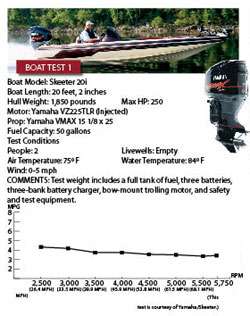
No sport has been more brutalized by high gas prices than tournament bass fishing, with the possible exception of 500-mile NASCAR races. First, you need a tow vehicle that will safely pull a bass boat. That eliminates pretty much anything that gets more than 20 miles per gallon. And, your tow vehicle's mileage can drop by 30 percent or more when you hitch a bass boat to it.Now for the really bad news: An 11-mpg tow vehicle is a hybrid go-cart compared to a bass boat. Although today's fuel-injected outboards get better gas mileage than ever, those 200-plus horsepower beasts typically get down near 3 mpg at wide open throttle. If you make a long, pedal-to-the-metal run, you can easily spend $150 or more on gas in a day's fishing.One obvious way to cut fuel costs is to fish closer to the ramp. But, competition being what it is, most tournament anglers will run as far as it takes to reach their best fishing spots. Another option is to downsize your boat and motor and sacrifice speed for better fuel economy.It's unlikely that professional bass anglers will take the latter route. This sport is their livelihood. They can't afford to let their competitors have more fishing time, which is exactly what would happen if they downsized.But, what about most bass fishermen — those who have regular jobs and compete in tournaments on weekends and during vacations? Can you downsize and still have a rig that allows you to compete at a high level? And, are the gas savings significant?
BOAT TESTS
The boat tests here should help answer these questions. We've included a variety of fiberglass bass rigs matched with 115-, 150-, 225- and 250-hp outboards. The speeds were determined by GPS units. The fuel flow and rpm data were taken from computers or gauges connected to internal computers on the outboards.
Because the tests were done at different times and places and with varying boat loads, they don't qualify as head-to-head performance tests. The intention here is to help you determine how much fuel, if any, you're likely to save with a smaller outboard or by operating your boat at lower rpm.The Bass Cat boats were rigged with Evinrude E-Tec outboards and tested by yours truly and Blain Schwarzel of Schwarzel Marine, a family owned and operated business in Hockingport, Ohio. The Yamaha-powered Skeeter and Ranger boat tests are courtesy of Yamaha, and the Mercury-Triton tests were performed by Jeff Rashid, pro staff manager at Triton Boats.
OVERVIEW OF TESTS
Most of the boats tested got their best fuel economy at midrange speeds while running somewhere between 3,000 and 4,000 rpm. As the rpm increased above the optimum range for fuel efficiency, the mileage decreased.However, with some boats the mileage actually improved at or near full throttle. For example, the Bass Cat Sabre powered by an Evinrude 150-hp E-Tec got 4.95 mpg when running at 3,000 rpm, dropped to 3.80 mpg at 4,500 rpm and increased to 4.35 mpg at 5,300 rpm. The reason for this is that the boat jumped up on its final pad at wide open throttle and less hull surface was touching the water. This reduced friction.
The best mileage at planing speeds was attained by the Ranger 170VS with a 115-hp Yamaha F115TLR, 7.37 mpg at 25.8 mph. The Triton 18X3 with a 150-hp Mercury OptiMax tied with the Bass Cat Sabre with a 115-hp Evinrude E-Tec for the best fuel economy at full throttle, 4.89 mpg. Compare that to 3.44 mpg at full throttle for a Skeeter 20i with a Yamaha VZ225TLR, and 2.81 mpg for the Ranger Z520 with a Yamaha VZ250TLR.It would take 20.5 gallons to go 100 miles at full throttle with the Sabre and the 115-hp E-Tec, nearly 50 percent less than the 35.6 gallons needed to go the same distance with the Ranger Z520. That would save you a bundle, given today's gas prices. But, you'd get there much faster with the Z520, which skims the water at 70.9 mph compared to 50.4 mph for the Sabre with the 115-hp outboard.The savings aren't as significant when you compare the fuel consumption of the boats at given speeds. In a few instances, a big rig actually got the best mileage.For example, the Triton 18X3 with the 115-hp Mercury OptiMax got 4.22 mpg at 41 mph, while the Triton Tr-20X HP with a Mercury 250-hp Pro XS fared better with 4.93 mpg at 40 mph.
These tests show that smaller boats and outboards generally yield better gas mileage at a wide range of speeds. But, if you run a big rig at the speed where it gets its optimum fuel economy, the difference in fuel consumption with a smaller rig powered by a 115-hp or 150-hp outboard is greatly reduced.
SEVEN FUEL SAVING TIPS
Put your boat on a diet. Bass fishermen are notorious for cramming tackle and other gear into their boat's storage lockers. Lighten the load by taking only what's needed for the body of water you're fishing.Keep your livewells empty until you catch a bass. At 8.33 pounds per gallon, the reduction in water weight will significantly impact fuel consumption.Slow down. Run your boat at its optimum speed for fuel efficiency when fun fishing and while practicing for a tournament. Save wide open throttle for tournament days.Maintain the proper trim to reduce hull friction. Your outboard must work harder when the trim is too low or high.Repair damaged props. Even a small ding reduces a prop's efficiency. That means you lose speed at any rpm and burn more gas.Keep your engine tuned and replace old spark plugs. This expense will pay for itself in gas savings.Consider buying a fuel flow meter. It will tell you when you're running at the most fuel-efficient cruising speed.





